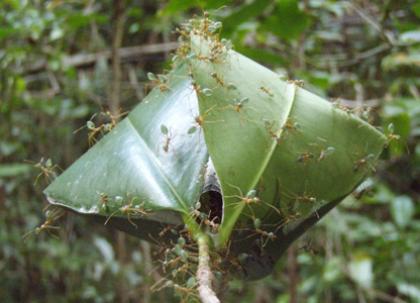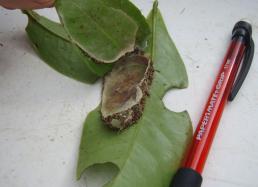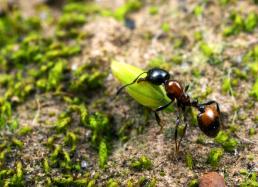3: Green Tree Ants & Other Species
A few days ago, I told you a bit about how ground-dwelling and tree-dwelling ants respond differently to environmental stresses. But I thought it might be nice to learn more about one of my favorite canopy-dwelling species: Oecophylla smaragdina—“green tree ants.” These jaunty and colorful little beauties live in the treetops and are part of an ant group nicknamed “weavers” because of how they construct their nests.
To build a new nest, two or more weaver-ant workers each straddle two leaves on a plant and begin to pull them together using their legs and jaws. Once the leaves are touching, another ant worker carefully carries over a larva held in her jaws and then signals the larva to start spinning silk. (The silk will be used to make a cocoon where the larva will eventually pupate, much like a caterpillar).
The worker moves the larva back and forth over the leaves, “sewing” them together until they are sealed tight. If you look carefully at the results of their handiwork in the photo above, you can see the silk around the edges of the leaves. Just as we would defend our home from intruders, you can also see that the workers (which are actually quite green in the photo) are ready to defend their nest from a curious ant biologist.
As you can imagine, when the climate begins to dry out and the leaves start to drop, the population of these tree-dwelling ants is dramatically affected. They can no longer build homes where they can safely reproduce, lay eggs, and nurture their young. They may roam to find new habitats, but it’s hard for insects adapted to moist micro niches to wander far across blighted areas.
So what would the disappearance of tree-dwelling ant species mean? A lot, actually. Not only are green tree ants a food source for other tree-dwelling animals, but they play a vital role in the Australian environment. For example, these industrious ants patrol the trees, killing off harmful insects that would damage the tree population (see Photo #2 below). That’s why many farmers work to establish green tree ant colonies in their mango and mandarin orchards—these ants are effective, safe, and free biological control agents. And they’re cute, too—what’s not to like?
Green tree ants are just one of many ant species that are vital to habitat health. For example, many species of ground-dwelling ants have huge colonies with nests that can cover acres of land. These nests aerate the soil and not only stir up nutrients but also increase the absorption and circulation of rainwater, which reduces runoff, especially in drought-prone areas.
And in drier areas of Australia, ant species of the genus Rhytidoponera are the primary agents for seed dispersal. They're thought to distribute more seeds than birds or any other creatures. Why is this important? By carrying seeds far from the parent plant, these ants reduce competition between parents and seedlings and help establish new populations.
And by transporting these seeds into their nests, the ants protect the seeds from drought and give them a nutrient-rich and predator-free place to sprout (see Photo #3 below). In fact, these ants actually aid sprouting by eating only the tough coating of many desert seeds, encouraging germination. Funny thing is, the plants recognize the benefits of ant dispersal, and about 1,500 plant species in Australia actually emitting chemical attractants that invite ants to spread their seeds.
Well, I think I’ve proven my point about the benefits of ants and why the extinction of an ant species could have a devastating effect on people, plants, and other animals. If you’d like to see more cool images of ants and learn more fun facts about their role in the environment, be sure to check out my Australian Ants Photo Gallery.
So tomorrow we head out on an eight-hour drive to the forests near Cooktown on the northern edge of the Australian Wet Tropics—stay tuned!
See you in Mount Cook National Park,
Dr. Corrie Moreau







